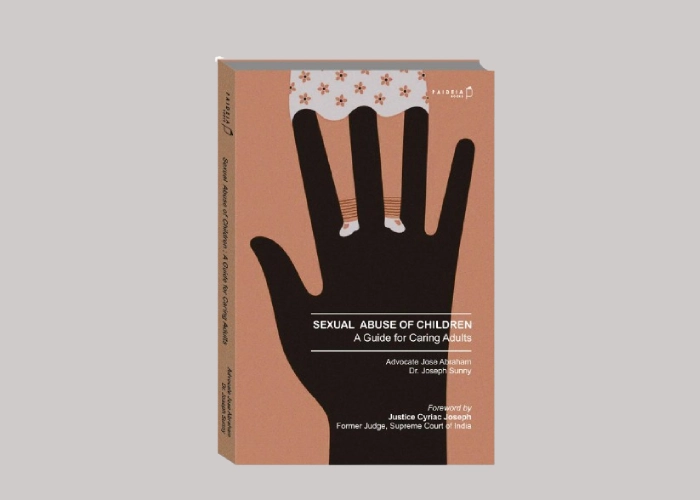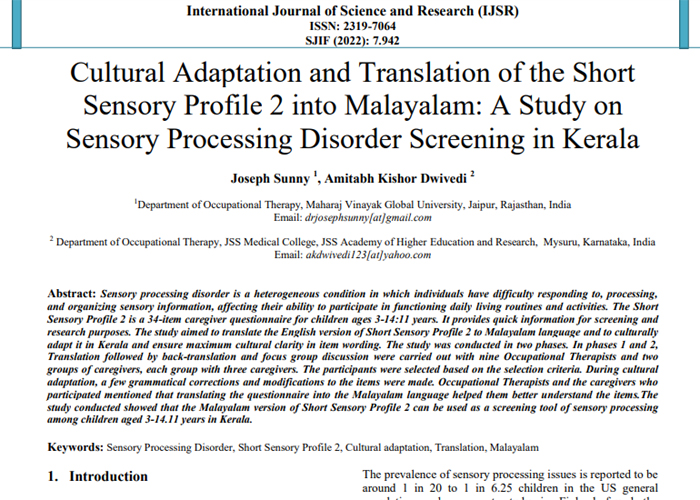Occupational therapy is a client-centred health profession concerned with promoting health and well-being through occupation. The primary goal of Occupational therapy is to enable people to participate in the activities of everyday life (WFOT,2012). Occupation here refers to the activities or roles a person wants to, needs to, or is expected to do every day for a meaningful and purposeful life. This is achieved by enhancing a person’s ability to perform an activity by modifying the occupation or the environment to promote his/her active participation.
Occupational therapists practise in different areas including paediatrics, neuro-rehabilitation, orthopaedics and mental health. OTs work along with medical professionals and also as a part of a rehabilitation team involving speech therapists, physiotherapists, clinical psychologists and social workers. Occupational therapy provides a holistic approach taking into account different aspects of a person’s everyday life from the mundane everyday activities to the environment wherein he/she spends most of their time. Holistic occupational therapy is the combination of occupational therapy framework with complementary and integrative health techniques which aim at healing on a deeper level.
Children’s occupations are the daily activities they engage in. A child participates in all different kinds of occupations throughout the day, including eating, toileting, learning, playing, etc. These occupations are essential to a child’s development. It ensures they become independent adults in the future. The active participation of parents or family members is very important in the development of a child. Parent involvement can promote the cognitive ability, language ability, action ability (gross and fine movement), social competence, and self-care ability of children. Occupational therapy attends to different conditions and disabilities in children including Autism Spectrum Disorder, ADHD and Cerebral Palsy among others.
OT in early intervention
In early intervention, occupational therapists promote the participation of infants, toddlers and their families in activities of daily living, play, education, social interaction, rest and sleep. Therapists help improve a family’s ability to care for their child and promote child’s development in the natural environment where the child and family live, work and play (AOTA, 2014).
Paediatric OTs in the NICU can provide early intervention services and support infants from day one of birth if their condition warrants it. Occupational therapy practitioners work along with developmental paediatricians and are specially trained to assess, create a plan and provide developmental treatment to help the baby participate in his/her “occupations”. The infant’s occupations include feeding, crying, bonding with the mother, exploring the immediate environment and playing.
Paediatric OTs encourage appropriate stimulation to develop sucking and swallowing skills in the infant. Therapists guide on adaptive positioning of the infant which helps to strengthen their muscles and encourages arm and leg movements, improves sleep and reduces stress. This lays the foundation for achieving future developmental milestones.
Paediatric OTs guide parents on the use of tactile, proprioceptive and vestibular stimuli to strengthen baby’s oral musculature and improve its functions for feeding. OTs encourage infant’s visual focus and assist in the development of social communication within the immediate environment. These activities facilitate a child’s bonding with the mother. With therapeutic intervention and parental guidance, an OT provides the most important tools required to respond to a baby’s needs and make him/her more comfortable. This encourages an infant’s physiological stability, serenity and the ability to interact with his/her environment.
Early intervention in NICU encourages better developmental results over the short and long term helping the child to achieve developmental milestones appropriate to his/her adjusted age.
Role of OT in Developmental delays
Gross motor skills
Gross motor skills make movements possible, which include walking, hopping, jumping, and climbing stairs. Some activities such as throwing or catching a ball involve eye-hand coordination along with gross motor skills. A child with a motor delay or difficulty may have trouble moving in a controlled, coordinated, and efficient manner. Difficulty in balance and coordination can make a child struggle with dressing or using cutlery, running or playing a sport. Occupational therapist helps to develop gross motor skills by improving core strength, balance, coordination of both sides of the body and body awareness through activities such as climbing on playground equipment, ball play, cycling, swimming etc.
Fine motor skills
Hand function has a larger consequence in occupational performance. Depending on the difficulty of hand function, impairment in skills varies, curtailing the child’s independence and involvement in academic, social and everyday activities. Children with hand function difficulties are generally limited in their ability to effectively complete daily life activities. It also hinders the development of skills that will support optimal performance in their occupation in future. In some kids, social participation gets limited due to limitations in their ability to participate on par with peers. This invariably affects their self-esteem and confidence.
Fine motor skills involve manual dexterity and often require coordinated movements of the hands and fingers with the eyes. Occupational therapists evaluate a child’s fine motor skills and understand how they use their fingers and hands and assess their strength. Therapists also look at bilateral hand skills and visual motor skills to understand the child’s abilities to coordinate hands and eyes together to execute tasks.
OTs help develop fine motor skills through fun activities and play which engage all their senses – this is referred to as multi-sensory learning. By working on developing children’s hand strength and skills, OTs prepare them for activities of daily living. Often therapists use playdough, cutting and gluing to help build strength and arches in the hands. Tearing paper and sticker activities help develop and improve pincer grasp and bilateral hand skills. Occupational therapists use different types of textures and crafts to build strength and develop the little hands for precise movement required for writing.
Play skills
A child’s primary occupation is play. Play helps them explore, and learn about the environment. It helps the child to develop joint attention, sequencing, turn-taking, shared interests, critical thinking, problem-solving, cooperation, and appropriate play with toys. Children may engage in different types of play such as solitary, pretend, constructive and/or peer interactions.
Some children may find it difficult to participate in play activities due to skill deficits in key functional areas. A child with a problem in balance and coordination may find it difficult to throw a ball while playing or a child with fine motor difficulties may find it hard to write or colour. Occupational therapists can assess and identify the problem areas in the child and provide treatment to improve the deficit skills. Occupational therapists use standardised and non-standardised assessment tools to identify developmental stages of play (K.Stagnitti, 2004). Play skills can be improved by providing opportunities to engage in play, and choosing activities that children might find interesting. Modelling by family members can help the child to learn how to play with a toy.
Sensory integration
Sensory integration is the process that helps us to take in an information received through all senses, organize it and respond appropriately. In sensory processing disorder, the brain has difficulty processing and responding to information from the senses. This can make specific sounds, textures, tastes or smells overwhelming for some kids and they try to avoid the unbearable sensation they feel. Some kids may need more sensory input which makes them touch or do things repeatedly to feel the physical contact and pressure. Sensory integration therapy is suitable for children with Autism Spectrum Disorder, ADHD, Learning disabilities, Sensory Processing Disorder etc.
Occupational therapists identify sensory and motor difficulties and provide interventions to facilitate effective self-regulation (wake-sleep cycles, alertness level, self-soothing), motor development, and adaptive behaviour. These interventions allow children to focus on successful occupational performance in areas essential for development, such as play, sleep, ADLs, mealtime routines, and socialization (Ayres, 2005; Schaff & Smith Roley, 2006).
Children with sensory issues may show features like getting distressed during haircutting, irritated by wearing shoes/socks and limiting self to certain food textures. In the school environment, children show features such as rushing through colouring/writing, taking excessive risks which makes them appear to be accident-prone, writing with excessive pressure, or having difficulty in remaining seated in the classroom.
A variety of sensory-based approaches can address life skills, participation, and behaviours needed at home, in the community, and in the classroom. Occupational therapists create a sensory diet which helps to calm and regulate a child’s emotions. This allows focusing, learning and behaving to the best of a child’s ability much easier.
In addition to direct intervention, occupational therapists modify home or classroom environments to help them participate in daily routines, self-care skills, focusing on learning, making friends and playing. (Ayres, 2005)
OT practitioners administer a Sensory Profile Caregiver questionnaire (Winnie Dunn, 1999) to identify sensory processing difficulties in children of various age groups. It helps to understand a child’s sensory processing patterns in everyday situations and profile the sensory system’s effect on functional performance for diagnostic and intervention planning.
OT in Learning disability
Children with learning disabilities may have problems in sensory processing, fine motor, visual motor, sitting tolerance, attention, time management, copying from board, posture and social behaviour. Occupational therapists work on rewiring their brain through activities which are fun and motivating to improve these skills.
The presence of soft neurological signs in these children affects various aspects of daily living. Soft signs refer to subtle abnormalities in sensory-perceptual, motor, or other central nervous system functions. They are findings that are pathological at any age, but more subtle manifestations of behaviours that are abnormal because they persist beyond a normal age. In contrast to hard neurological signs, they are nonspecific indicators of impairment and are not associated with focal brain dysfunction or any specific disease process. Examples of neurological soft signs (NSS) include clumsiness, motor incoordination, motor overflow, difficulty with motor sequencing or rapid successive movements, stereognosis or graphesthesia, right-left confusion, and extinction in response to double simultaneous stimulation (Patankar V.C., 2012). Persistent primitive reflexes such as ATNR, STNR leads to delays in developmental stages. These reflexes may affect the motor, cognitive and behavioural skills of children (Konicarova J., 2013).
An occupational therapist helps to improve pencil grip, sitting posture, shoulder stability and core muscle strength. Occupational therapist uses strategies to improve skills such as attention, memory, organisational skills, time management skills etc which improves a child’s participation in daily life.
Occupational therapy in adult rehabilitation
In adult neuro-rehabilitation, occupational therapists work in collaboration with other professionals in the rehabilitation team including speech therapists, physiotherapists, clinical psychologists, neurologists, neurosurgeons, and orthopaedic surgeons. The focus of occupational therapy is to approach the patient’s care holistically.
In neuro-rehabilitation, occupational therapists help patients post-stroke or head injury to improve their activities of daily living. The treatment process involves the use of selected activities and assistive devices to restore the client to the highest level of independent function.
In adult rehabilitation, Occupational therapy practitioners with specialization in ergonomics deal with work-related injuries and modification of work settings to optimize function. Vocational evaluative methods are employed to identify the individual’s capacities and deficits in occupational performance. OTs design and modify workplace, work equipment, tools and behaviour to prevent injury. Therapists also guide on posture, mobility, self-care etc. In India, leading furniture showrooms are now manufacturing ergonomically designed school and office furniture duly verified and certified by AIOTA’s inspection committee to ensure a safe and healthy work environment.
The specific aim of occupational therapy is to assist the individual in recovery or to develop competence in the physical, psychological, social, and economic aspects of daily living and to provide opportunities to learn those skills needed for adaptation in education, work, home, and community environments.




